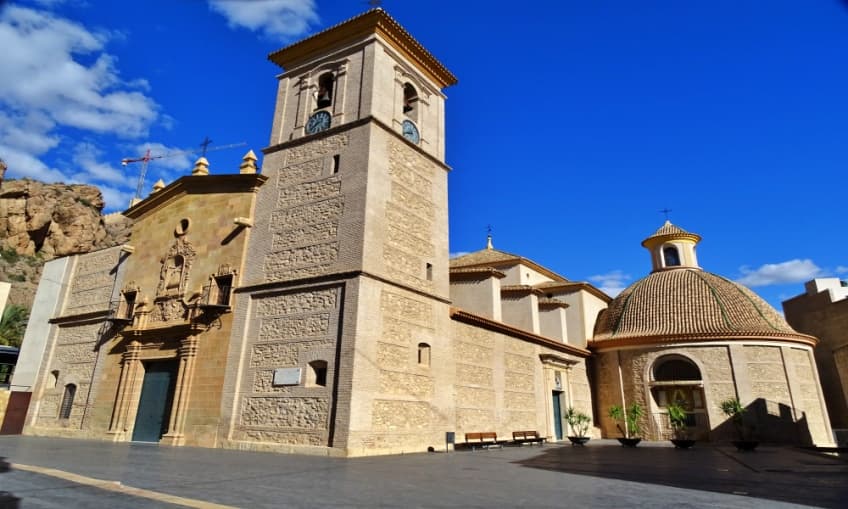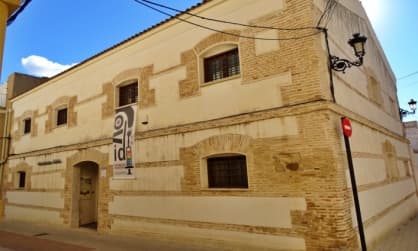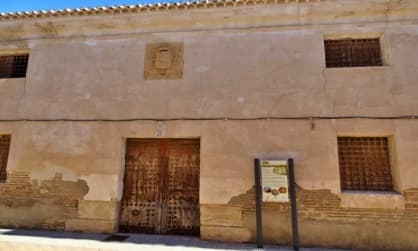
What to see in Alhama de Murcia
Church of Saint Lazarus Bishop

This Baroque and neoclassical temple dates from the 16th century, although throughout its history it has undergone several extensions and modifications.
This church is one of the most emblematic monuments of local history. Also, its religious character has emotional value for the people of Alhama de Murcia.
During the 18th century, the construction of the new main chapel and the transept, where the dome is housed, was carried out.
This church is one of the most emblematic monuments of local history. Also, its religious character has emotional value for the people of Alhama de Murcia.
During the 18th century, the construction of the new main chapel and the transept, where the dome is housed, was carried out.
Its interior is made up of a single nave, where you can see the neoclassical-style sacristy made by the architect Lorenzo Alonso. We can also appreciate the chapel of the Communion, which contains an altar where the image of the patroness saint of Alhama de Murcia, the Virgin of the Rosary, is placed.
Old Square Cultural Centre

This old mansion from the 18th century served as the seat of the Town Hall. It owes its name to the place where the distinguished Old Square of Alhama de Murcia is located.
The square is currently surrounded by brightly coloured buildings. In its heyday, it was the social, political and economic epicentre of the city, where the town's first source of drinking water was located. The Cultural Centre currently functions as the headquarters of the Public Library and the Plaza Vieja Exhibition Hall.
The square is currently surrounded by brightly coloured buildings. In its heyday, it was the social, political and economic epicentre of the city, where the town's first source of drinking water was located. The Cultural Centre currently functions as the headquarters of the Public Library and the Plaza Vieja Exhibition Hall.
Food Market

Located in the heart of the city, this was built in 1928 and has since functioned as a meeting place and market.
The building stands out for its simplicity, with an entrance in the form of a semicircular arch framed by two pillars on both sides. Inside is a large, triangular-shaped patio in which all the stalls that sell in the market are distributed.
Among them, you can find all kinds of products such as fresh fruits, meats and sausages.
The building stands out for its simplicity, with an entrance in the form of a semicircular arch framed by two pillars on both sides. Inside is a large, triangular-shaped patio in which all the stalls that sell in the market are distributed.
Among them, you can find all kinds of products such as fresh fruits, meats and sausages.
Los Baños Archaeological Museum
This is an archaeological complex that was inaugurated in 2005 and in which the remains of an ancient Roman spa, some Islamic baths and a spa hotel from the 19th century are preserved.
The museum is currently composed not only of the area containing the archaeological finds but also of a garden that surrounds the visitor with the sounds of water as well as various types of plants and landscapes, evoking the gardens of antiquity.
The museum is currently composed not only of the area containing the archaeological finds but also of a garden that surrounds the visitor with the sounds of water as well as various types of plants and landscapes, evoking the gardens of antiquity.
Inside the museum are also innumerable everyday, commercial and decorative objects that were present and used by the civilizations of that time. The museum’s cultural exhibition hall seeks to provide the visitor with an extensive cultural offer in terms of activities such as photographs, videos, music and exhibitions.
Town Hall of Alhama de Murcia

Originally, this 20th-century mansion belonged to the Artero family. In 1986, it was renovated for use as the Town Hall.
Its structure is rather square and is distributed over two floors and a basement, befitting the buildings of the time.
The facade has a classic Mediterranean style, with several windows and balconies distributed throughout the floor, making it a colourful attraction for visitors.
Its structure is rather square and is distributed over two floors and a basement, befitting the buildings of the time.
The facade has a classic Mediterranean style, with several windows and balconies distributed throughout the floor, making it a colourful attraction for visitors.
Castle of Alhama de Murcia
Also known as La Fortaleza de Alhama, this building has its origins in Islamic times. It was active throughout the Middle Ages until its abandonment in the 16th century. From a geographical point of view, the castle is located on a hill which gave it a strategic position for controlling the region. The walled fortress is articulated by two enclosures: an upper one located to the north, which was dedicated to military and political issues, and a lower one located to the south, which was intended as a refuge for the local population.
Municipal Deposit

The deposits’ main objective was to regulate the grain trade and guarantee its supply to the entire region.
In particular, the one in Alhama de Murcia is an old building from the 18th century, with a simple and rectangular structure containing two floors. It was made from simple materials such as brick and masonry.
The ground floor had several divisions that were intended for the storage of grains.
In particular, the one in Alhama de Murcia is an old building from the 18th century, with a simple and rectangular structure containing two floors. It was made from simple materials such as brick and masonry.
The ground floor had several divisions that were intended for the storage of grains.
House of Terce

This building was declared an Asset of Cultural Interest. In its time, it functioned as a barn-house and was used to store part of the cereal harvest.
The House of Terce was built by order of the Marquis of Los Velez in 1755. During the 19th century, it was remodelled for use as a hall for social celebrations. Another of its many uses was as a theatre school and for cultural activities at the beginning of the 20th century and as a prison during the Spanish Civil War.
The House of Terce was built by order of the Marquis of Los Velez in 1755. During the 19th century, it was remodelled for use as a hall for social celebrations. Another of its many uses was as a theatre school and for cultural activities at the beginning of the 20th century and as a prison during the Spanish Civil War.
Church of the Conception

With its distinctive colour and imposing bell tower, the old hermitage of the Conception, today declared as a church, was one of the main religious elements of the town.
Its construction dates back to the 17th century. Today, the building is a remodelling of the original version.
The surface of the church is distributed between its central nave along with its lateral ones, which were built during the 20th century, as well as the addition of the tower.
Its construction dates back to the 17th century. Today, the building is a remodelling of the original version.
The surface of the church is distributed between its central nave along with its lateral ones, which were built during the 20th century, as well as the addition of the tower.
The hermitage is currently in the Diocese of Cartagena. In ancient times, the head of the hermitage was linked to the now non-existent convent-hospice with two floors.
What to see in the Bajo Guadalentin












